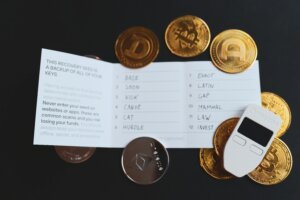Bitcoin 101: What Is Bitcoin and How Does It Work?
In the wake of the 2008 global financial crisis—a time when banks collapsed, governments bailed out corporations, and trust in traditional finance eroded—a mysterious figure (or group) known as Satoshi Nakamoto unleashed something revolutionary: Bitcoin.
This wasn’t just another digital payment system. It was a new form of money—one that operated without banks, borders, or centralized control. Its creator vanished shortly after its launch, leaving behind a financial enigma that has since sparked a global movement.
If this sounds like the plot of a cyberpunk thriller, that’s because—in many ways—it is. Except it’s real.
In this beginner’s guide, we’ll explore:
✔ What Bitcoin really is (and why it’s unlike any money before it)
✔ The mysterious origins of Bitcoin (Who is Satoshi Nakamoto?)
✔ How Bitcoin works (Blockchain, mining, and decentralization)
✔ Why Bitcoin could change the future of money
Let’s explore this together!
What Is Bitcoin? (The Digital Gold Revolution)
Bitcoin (BTC) is the world’s first decentralized digital currency. Unlike traditional money (like the dollar or yen), Bitcoin isn’t controlled by any government, bank, or corporation. Instead, it operates on a peer-to-peer network secured by cryptography and maintained by thousands of computers worldwide.
Key Features of Bitcoin:
- Decentralized – No single entity controls Bitcoin. It’s run by a global network of users.
- Censorship-resistant – No one can freeze your Bitcoin or block transactions.
- Transparent & Immutable – Every transaction is recorded on a public ledger (the blockchain) and cannot be altered.
- Borderless – Send Bitcoin to anyone, anywhere, without banks or intermediaries.
- Scarce – Only 21 million Bitcoins will ever exist, making it a deflationary asset.
Bitcoin is more than just digital cash—it’s the cool kid crashing the old financial system’s party.
The Mystery of Satoshi Nakamoto: Who Created Bitcoin?
So who created Bitcoin? No one knows for sure! Bitcoin was created in 2008 by a mystery person (or group) using the name Satoshi Nakamoto. Could be a guy, could be a gal, could be a team of cyberpunks in hoodies—no one’s ever confirmed who Satoshi really is.
Satoshi dropped Bitcoin right after the 2008 financial crisis—a time when banks were being bailed out and regular people were getting screwed. Bitcoin was designed to let people send money directly to each other without needing a bank. The idea was to create a currency that no one—not even governments—could control. It would be transparent, decentralized, and powered by code instead of middlemen.
Basically, it’s like Satoshi looked at the financial system and said: “Nah, we can do better.” 😉
What We Know (and Don’t Know) About Satoshi:
✔ Published the Bitcoin whitepaper in 2008
✔ Mined the first Bitcoin block in 2009
✔ Disappeared in 2010, leaving Bitcoin in the hands of developers
❌ True identity remains unknown—was it one person? A group? A government experiment?
Some believe Bitcoin was the first real step toward freedom in a world dominated by financial gatekeepers.
How Does Bitcoin Work? (The Blockchain Explained)
Bitcoin runs on blockchain technology, which is basically a decentralized ledger that records every transaction for all to see. Here’s how it works in simple terms:
When someone makes a Bitcoin transaction, it’s broadcast across the network. These transactions are collected into something called a block. But before that block gets added to the blockchain, miners—people using powerful computers—compete to solve a complex cryptographic puzzle. This process is called Proof-of-Work.
Whoever solves the puzzle first gets to add the block to the blockchain and is rewarded with newly minted Bitcoin. Once added, the block becomes permanent—it can’t be changed. That’s because thousands of computers around the world (called nodes) each hold a copy of the entire blockchain, making it almost impossible to tamper with.
All of this works without banks or governments. Just code, consensus, and a whole lot of math.
The Public Ledger: Bitcoin’s Transparent Record-Keeper
Every Bitcoin transaction is recorded on the blockchain, a permanent and publicly accessible ledger. But unlike a traditional ledger stored in one central location, the Bitcoin ledger is decentralized—copies are held on thousands of computers (called nodes) all around the world.
This setup brings full transparency to the system. Anyone can view the entire transaction history at any time, though identities remain hidden behind cryptographic addresses. And once a transaction is confirmed, it becomes part of the blockchain forever—it can’t be reversed, edited, or erased.
Key Facts About the Bitcoin Ledger:
✔ Decentralized Storage – The blockchain isn’t stored in one place; it’s replicated across thousands of nodes.
✔ Full Transparency – Anyone can view all transactions (but identities are hidden behind cryptographic addresses).
✔ Unchangeable History – Once a transaction is confirmed, it cannot be reversed or altered.
This makes Bitcoin both transparent and secure—a radical departure from traditional banking.
What Is a Satoshi? (The Smallest Unit of Bitcoin)
You don’t need to buy a whole Bitcoin to get started. In fact, Bitcoin is designed to be highly divisible, and the smallest possible unit is called a satoshi, often shortened to sat. Just like a dollar has cents, one Bitcoin is made up of 100 million sats.
| Unit | Amount in BTC |
|---|---|
| 1 Bitcoin | 1 BTC |
| 1 satoshi | 0.00000001 BTC |
The name “satoshi” is a tribute to Satoshi Nakamoto, the mysterious creator of Bitcoin. It’s a way to honor the person (or people) behind the idea that sparked a new era in digital money.
Because of this divisibility, many people choose to slowly accumulate Bitcoin over time by collecting small amounts—this is known in the crypto community as “stacking sats.” It’s a popular approach for newcomers and long-term believers alike, making Bitcoin accessible to everyone, not just big investors.
How to Get Started with Bitcoin
Thinking about diving into the world of Bitcoin but not sure where to start? Whether you want to buy your first coins, safely store what you already have, or even try your hand at mining, here’s a quick roadmap to guide you through the basics and help you take the first steps with confidence.
- Buying Bitcoin – Use exchanges like Bianace, Coinbase or Kraken.
- Storing Bitcoin – Secure it in a hardware wallet (Ledger, Trezor) or a software wallet.
- Mining Bitcoin – Requires powerful computers (ASICs) and cheap electricity.
Taking the time to learn and prepare will help you navigate the exciting world of Bitcoin safely and successfully.
Why Bitcoin Matters: The Future of Money?
Bitcoin isn’t just a currency—it’s a movement. It challenges:
Central banks (by offering an alternative to fiat money)
Bitcoin offers a decentralized alternative to fiat currencies, removing the need for central bank control. This allows individuals to store and transfer value without being affected by government monetary policies or currency devaluation.
Censorship (by enabling permissionless transactions)
Bitcoin enables permissionless transactions that cannot be easily censored or blocked by governments or institutions. This empowers users in restrictive regimes or under financial sanctions to maintain access to global financial systems.
Inflation (with a fixed supply of 21 million BTC)
With a hard cap of 21 million coins, Bitcoin resists inflation caused by money printing. Its scarcity makes it a potential hedge against the loss of purchasing power in traditional currencies.
Whether Bitcoin becomes the global reserve currency or remains a digital gold, one thing is certain: Money will never be the same again.
Conclusion
By the end of this guide, you’ll have a clear understanding of Bitcoin’s origins, how it works, and why it has the potential to reshape the way we think about money and trust.
Stay tuned for more detailed guides coming up soon!






Comments